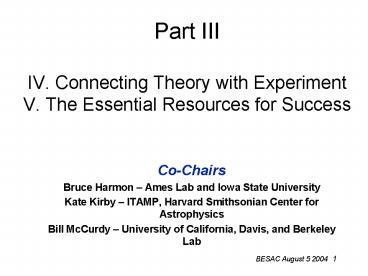BESAC August 5 2004 1 - PowerPoint PPT Presentation
1 / 9
Title:
BESAC August 5 2004 1
Description:
Kate Kirby ITAMP, Harvard Smithsonian Center for ... Neutron Reflectometer. Facility. User. Community. User. Community. Instrumentation. Materials Science ... – PowerPoint PPT presentation
Number of Views:39
Avg rating:3.0/5.0
Title: BESAC August 5 2004 1
1
Part IIIIV. Connecting Theory with
ExperimentV. The Essential Resources for Success
- Co-Chairs
- Bruce Harmon Ames Lab and Iowa State University
- Kate Kirby ITAMP, Harvard Smithsonian Center
for Astrophysics - Bill McCurdy University of California, Davis,
and Berkeley Lab
2
Connection (?) of the Theory Program with the BES
Facilities
- APS, ALS, NSLS, IPNS, LANSCE, HFIR,
- All have little or no associated theory program
- Users must find theoretical collaborators who are
willing and already funded to work on their
problems.
Finding Need stronger coupling of theory and
computation with experiments at BES facilities.
- Committee and Testimony
3
New Major Experimental Facilities Theoretical
Support and Guidance - Strategy for
SuccessAsking the Right Questions and
Understanding the Answers
- 5 Nanoscience Facilities
- Spallation Neutron Source
- Linac Coherent Light Source
- Motivation to integrate theory partnership in the
planning stages to accelerate discoveries and
understanding to enhance efficacy of facilities.
4
Integration of the Theory Program with the BES
Facilities
- Enhance Scientific Productivity
- Mature area interpretation of experiments
(allowing meaningful pursuit of more complex
systems). - 2. Emerging area suggest new areas of inquiry
and propose new kinds of experiments.
5
Integration of the Theory Program with the BES
Facilities (cont.)
- Mode Coupling - Issues
- In house or distributed
- Directed or Blue Sky
- Collaborative Research Teams or Single PI
6
Computational Materials Science Network
A new approach Advance frontiers in
computational materials science by assembling
diverse sets of researchers committed to working
together in order to solve outstanding materials
problems that require cooperation across
organizational and disciplinary boundaries.
Excited State Electronic Structure CRT
Theory vs. Experiment silicon nanoclusters
7
Infrastructure, Resources and Support for BES
Theory in the Modern Era
- What is necessary to enable the BES Theory
Program to be successful in the era of
leadership-scale computing? - A hierarchy of computational resources is
necessary to express modern theory - Leadership Scale Capability
- High Performance, Massively Parallel, Large Scale
Capacity - Local computing resources - clusters
- It takes a healthy and large base to fuel the top
end.
8
A Distinguishing Role for DOE Infrastructure for
BES Theory
- Support for long-term software projects
building the community codes as infrastructure
for theory and experiment - European programs have set an example
- VASP/WIEN Project in Vienna, CCCP at Daresbury,
R-matrix code project in the U.K. - Another example is NIH funding of Klaus Shultens
work on NAMD at Illinois (synergy with computer
sciences) - Should we have a Renewal and Expansion of the
SciDAC style of large scale project support in
BES? - Only Chemical Sciences participated in SciDAC and
only for 2M / yr.
9
New Approach Facilities analogy
User Community
Spallation Neutron Source (SNS) Center for
Nanophase Materials Science (CNMS)
Facility
Instrumentation
- NERSC
- 3,328-processor
- 5 teraflop/s
Fe































